Donnybrook Fair: carnival versus lent
Published in 18th-19th Century Social Perspectives, 18th–19th - Century History, Features, Issue 1 (Spring 1996), Medieval History (pre-1500), Volume 4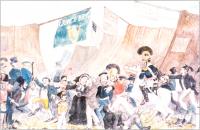
Donnybrook Fair, 1830.
(National Library of Ireland)
In 1829 a Dublin carman named Foley was charged with ‘furious driving’ in Sackville Street while going to post a letter for a gentleman in the Post Office. When asked what he had to say for himself, he pleaded with the magistrate, ‘Oh, Sir, these is Donnybrook times and everyone is merry now, if you let me off I’ll be aisy for a week’. The magistrate was not impressed and he fined him a pound.
Carnival in Europe
The Dublin carman was expressing a feeling shared by many of the ordinary people throughout Europe for many centuries that their festival time was special, a time set apart from their ordinary lives when the normal rules of behaviour and constraints did not apply. The reaction of the magistrate epitomised the growing attitude of non participation by the agents of official culture in such popular customs as Donnybrook Fair.
In southern Europe carnival was the greatest popular festival of the year; it was a time of liberation when one couId escape the drudgery of everyday life and engage in behaviour which would not be permitted with impunity at other times. Carnival in southern Europe centred on Shrove Tuesday, of course, but elements of the festival—the ‘carnivalesque’—could be found in popular festivals in other places and at other times of the year. Examples were the Feast of Fools (28 Dec.) in France and May Day and St John’s Eve in England and other places. In northern Europe the climate more than likely discouraged the holding of carnival at Shrovetide and it was given over to more domestic indoor rituals. Nevertheless Donnybrook Fair took on many aspects of the ‘carnivalesque’; it became the carnival of Dublin.
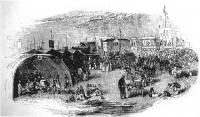
(Hall’s Ireland)
Origins
The Normans stimulated trade in the areas under their control in the twelfth and thirteenth centuries by the establishment of great fairs and in 1204 King John commanded Meiler Fitzhenry, Justiciar of Ireland, to build a castle at Dublin and establish a fair at Donnybrook and at three other places in the country:
We will also that there be a fair at Donniburn [Donnybrook] annually to continue for eight days on the Feast of the Invention of the Holy Cross.
The feast of the Invention of the Holy Cross fell on 3 May but the date for holding the fair was later changed to 26 August, which became the traditional ‘fair day’ up to the time of its demise.
It is possible that there was a popular gathering taking place at Donnybrook before this. Donnybrook was a border area; it was on the banks of the Dodder at a fording place on the fringes of the jurisdiction of the city as granted by John to Dublin in 1172. From early times neutral ground like this was important for inter-tribal parley and barter, and Donnybrook was probably used as such by the city population and its rural neighbours. It was also a church site and the fair green adjoined the ancient graveyard. For long fairs and popular gatherings have been associated with burial places and many of the early monasteries, such as Glendalough, had market crosses.
Food, drink and sex
The elements of the carnivalesque associated with popular festivals were indulgence in food and drink, athletic competition like foot races, a greater sense of communal solidarity celebrated by music and song, the playing of pranks and the staging of plays, especially those featuring a world turned upside down, and enhanced sexuality and indulgence in violence.
Eating and drinking were central activities on the fair green. Numerous signs strung over the tents invited the passer-by to indulge in the delights within—’sirloins, ribs, rounds, flanks, shins, briskets, six dozen boiled chickens, 28 Wicklow hams, kishes of potatoes carts of bread and gallons of punch’ in one tent in 1823. To provide hospitality for the fair-goers leading vintners and hoteliers from the city set up such tents on the green, some of them quite sumptuous. In 1833 a M’Namara of Kevin Street had a tent called the ‘Shamrock, Rose and Thistle’ and the proprietor of the Carlingford Beefsteak Tavern, Aston Quay had a tent where the ‘grub and lush’ were said to be excellent.
Figure 1 features a woman cutting a large joint of meat called a ‘spoleen’ and the typical boiling pot found simmering all over the fair green can be seen in figure 2, although what is being extracted from it does not look all that appetising. The signs strung over the tents celebrated the ‘humours’ of the occasion. Frank Thorpe Porter, police magistrate, observed:
Here Paddy comes to have a swig,
A better one he never took;
And now he’ll dance an Irish jig
With Dolly Dunne of Donnybrook.
And an 1822 couplet:
Entertainment here for all who pass,
For horse, or mare, or colt—or ass !
‘Rural pastimes’
Another recurrent element of carnival was competition such as footraces, horseraces and football matches. Down to the early years of the nineteenth century such participatory sports, which the Dublin newspapers termed ‘rural pastimes’, seem to have been the main form of entertainment at Donnybrook. A well-known song ‘The Humours of Donnybrook’, outlines some of these:
O you lads that are witty from famed Dublin city,
And you that in pastimes take any delight,
To Donnybrook fly for the time’s drawing nigh,
When fat pigs are hunted and lean cobblers fight:
When maidens so swift run for a new shift;
Men muffled in sacks, for a shirt they race there;
There jockeys well booted and horses sure footed,
All keep up the humours of Donnybrook Fair.
At the fair of 1815 a motley crew of thousands took part in such games as ‘Kiss in the ring’, ‘Thread my needle, Nan’ and ‘Hunt the slipper’. As the nineteenth century wore on and leisure became commercialised large English menageries and shows saw the advantages of appearing before the huge crowds which attended Donnybrook. Such elaborate outfits as Polito’s and Wombwell’s became regular visitors and took over from the participatory sports and games.
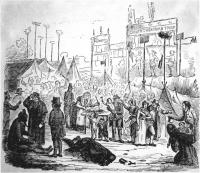
Dublin Penny Journal, 16 November 1833.
The freakish and the grotesque
The display of the freakish and the grotesque emphasised the contrast with the mundane and the everyday. Levi Leach, a contortionist known as ‘the American Youth’, performed on the fair green in 1815. He had just arrived from new York, it was claimed, and had played before the President of the United States. The ‘Irish Giant’, ten feet in height, drew the attention of the crowds in 1823.
In southern Europe the theatrical was at the centre of carnival and it became a central feature at Donnybrook and for many the highlight of a visit to the fair. The booths in which the performances took place were barn-like structures of wooden boards, narrow in shape. External balconies were a common feature on which barkers strutted and actors paraded to draw the crowds.
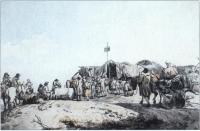
Outside the Ale Tent at Donnybrook by Francis Wheatley.
(Courtesy of The National Gallery of Ireland)
Hamlet in twenty minutes
On the fair green in 1828 Scott’s Melodramatic Theatre ‘raised its gorgeous front’ above all the theatres. The dramatis personae, male and female, attired in tawdry trappings, trimmed with tags and tassels were to be seen promenading the platform. Abridgements and adaptations were the lifeblood of the shows. Hamlet could be done in twenty minutes. The great favourite, however, was Othello, possibly because the character of the Moor was easy to assume. The owner of the booth would often stand at the side of the stage with a watch and cry out, ‘the time is up—commit the murder and down with the curtain’. The audience would then be ushered out and a new one brought in.
While a central element of carnival, the notion of the world turned upside down, was not overtly celebrated at the fair as at European carnival, release of tension was expressed in the playing of practical jokes, ‘larking’ or ‘roasting’, a real hazard to those who remained late at the fair. A common trick played on a newcomer to a tent was to leave one seat vacant which immediately collapsed as soon as it was sat upon. In 1833 six gentlemen who were dining in a tent, found before the conclusion of the repast that the tails of their coats had been cut off by some joker from the outside.
‘The Tack’em’
The numerous craftsmen and apprentices who went to the fair each year looked on it as a release from their very constrained daily lives; for these young people the sexual cycle of the year turned on such festivals. Much dancing and lovemaking were carried on the fair green. It was a common feature of the fair that a defrocked clergyman set himself up in a tent and married, for a fee, any couple who presented themselves. The most famous of these was a renegade known a ‘The Tack’em’, presumably because he tacked a couple together. This was a German clergyman whose real name was Schultz. He lived near Cullenswod and in a lament for Donnybrook composed by John McCall in 1856 ‘The Tack’em’ is referred to;
The Sandymount gatherings are fled
Rathmined dance is knocked on the head
And the Cullenswood Tack’em is dead
Who tied tight each pair from the Fair.
A salutary warning was given to all those in the position of fathers and brothers of young girls visiting the fair of 1829. It was said that any one of them, if they viewed the fair with a scrutinising eye, would have seen ‘the coy maid half willing to be pressed’ go into a tent at night with all the boldness of an experienced courtesan. The parliamentary report on intoxication of 1834 corroborates what was said of the danger to young women. C. Graves of the Police Head Office in his submission stated that Donnybrook Fair every year was regularly followed by a fresh supply to the streets of unfortunate young women who owed their ruin to ‘its intemperate orgies’.
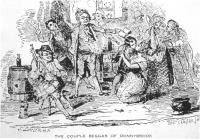
The Couple Begger of Donnybrook by Samuel Lover, RHA.
Mock battles and cudgel play
After indulgence in food, drink and sex another major theme of carnival was violence. Much of the violence was sublimated into ritual such as mock battles and cudgel play in a similar way much of the sex was expressed in innuendo and double meaning. The name of Donnybrook has for long been a by-word for violence. Indeed the village, now an inner suburb of Dublin, bears one of the few Irish place names to have given a word to the English language. The Oxford English Dictionary defines ‘Donnybrook’ as ‘scene of uproar and disorder; a riotous or uproarious meeting, a heated argument’. Its use has been recorded wherever English is spoken, in America and Australia for instance.
An event which gave a word to a language must have attained mythic proportions and a myth has grown up around Donnybrook Fair. It came to epitomise the gaiety of the Irish peasantry and their alleged fiery temperament which made them as ready to whack a head with a shillelagh as step out for a jig. This myth, popularised by writers like Jonah Barrington and propagated in song and print, is corroborated in eyewitnesses’ reports which begin to appear in the newspapers from the early 1700s. It reached a climax in the mid-eighteenth century when two notorious Dublin factions, the Liberty weavers on the south side and the Ormond butchers of the north side used the cover of large crowds to continue their usual rivalry.
A reading of newspaper accounts for the years of the craze of rural faction-fighting in the nineteenth century pre-Famine years does not show a corresponding Donnybrook phenomenon, despite popular conceptions. It does catalogue a woeful tale of drunkenness, dissipation and criminal violence which gives the lie to the veneer of Victorian respectability.
Increasing opposition
The movement for the reform of popular culture, which began in a concerted way in the Christian churches in the sixteenth century, has been termed ‘the triumph of Lent’. By the time we have attitudes to Donnybrook Fair recorded a second wave of denunciation was taking place; in this case the laity joined the clergy as agents of reform. The proponents of official culture, who became increasingly hostile to the fair, were the government, the municipal authorities, particularly the Lord Mayor, employers, and upper class gentlemen, especially those residing near Donnybrook and on the route to the fair green from the city. Added to these was the newly reformed police establishment and of course the clergy, both Catholic and Protestant.
The view of the city’s apprentices and tradesmen that the fair was an occasion of release was increasingly frowned upon by the city’s employers who saw it as a resort of scoundrels, thieves and errant youth. In the 1790s the ‘moral economy’, which had linked landlord and tenant in bonds of patronage and deference, gave way to a sharper, adversarial relationship as the impact of the French Revolution stimulated greater class-consciousness. In Ireland this led to the rebellion of 1798 and its murderous passions. In the light of this, popular pastimes and large gatherings began to be looked upon with increasing suspicion by the powers-that-be.
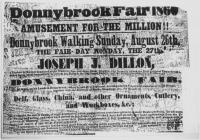 The Madden patent
The Madden patent
Attempts to curtail the fair, which tended to last for up to two weeks or as long as the pleasure-seekers’ money held out, or completely suppress it, met formidable opposition in the Madden family, who held the patent. Dublin Corporation had sold it off in an attempt to clear debts in the 1690s. The civic authorities lived to regret their rash action and controlling the fair became an annual chore for successive Lord Mayors.
The first really successful attempt was that of Richard Smyth in 1824, when he banned the fair on the Sabbath. William Hodges made a similar attack on the fair in 1837 after it had reverted to its usual lawlessness. The rise of the temperance movement and the Famine years saw a change in the habits of the people which paved the way for the decisive action to come.
By the time the fair of 1850 came round John Madden, the chief obstacle to any interference to the fair, had died and the way was cleared for complete suppression. The patent passed to Eleanor Madden, John’s sister and when Fr. Nolan, a zealous young curate arrived in the Donnybrook end of the combined Irishtown, Ringsend, Sandymount and Donnybrook parish, she was ill-equipped to withstand his persuasive promptings. She was an elderly lady from a pious family, but one which had withstood for decades the moral pressure for the curtailment of the fair, even from their archbishop. But the days of lay independence from the clergy were numbered in Ireland. The problem had been that the fair was held by royal charter and could not be legally interfered with. In 1855 Eleanor Madden agreed however to sell the fair’s charter to Fr. Nowlan and his associates. The asking price was £3,000 and a committee was formed to purchase it. A fund-raising campaign was initiated with the backing of both Catholic and Protestant clergy, the municipal authorities, the respectable and the godly.
The abolitionists addressed an appeal by circular to the ‘Nobility, Clergy, Gentry, Merchants and Shopkeepers of the City of Dublin and its Vicinity’ requesting their co-operation. The money was collected, not without a certain degree of difficulty, over the summer of 1854. The clergy were quick to respond and even the police commissioners and the military added their mite. Major General Falls stated that he was delighted to be able to remove such an occasion of temptation from the path of his men—what his men thought of the demise of one of their favourite haunts is not recorded.
Joseph Dillon’s fair
It came as a shock to the committee to read a proclamation, which appeared in conspicuous places in the vicinity of Donnybrook in July, headed ‘Important to the Public—Donnybrook Fair’ and signed by Joseph Dillon. In it he stated that as the time for holding the fair was drawing near he was now apportioning places on his land in Donnybrook to respectable parties for theatrical amusement and the like as he had done annually for upwards of thirty years. After his signature he made sure to point out that he was the nephew of the late John Madden who had owned the fair green
This notice, not surprisingly, came to the attention of the police. After taking legal advise it turned out that Dillon’s fair could not be interfered with and could go ahead on his own premises as long as the law was not violated. It was recommended to the committee to make it clear that they would not permit the fair on the old fair green nor any trespass on it and that the drinking and public order laws would be strictly enforced. The Dillon family played cat and mouse with the law for a number of years, with a certain amount of support from the public, but the fair of old was a thing of the past. The church denounced his attempts to uphold the annual rites with a pastoral letter read in all churches in Dublin shortly before the ‘fair’ of 1860.
1866 showdown
So matters continued until the momentous year of 1866. It was decided that the new Catholic church which was to open in Donnybrook would be dedicated to the Sacred Heart in reparation for all the sins committed on the fair green over the centuries. A site on the far side of the Dodder was chosen as it overlooked the scene of ancient infamy. To symbolise the victory of virtue over vice there was only one date on which the grand and solemn opening of the church could take place—Walking Sunday of time immemorial, the Sunday immediately preceding 26 August or on which the 26th fell, on which thousands annually walked to the green to see the preparations for the fair. Propitiously enough it fell on a Sunday in 1866.
The great day dawned in Donnybrook as Joseph Dillon opened the field attached to his public house. The crowds were already gathering for the opening of the new church and a large contingent of gamblers and pleasure-seekers, many of them trying to hide their wheels of fortune under their coats, mingled with the pious. But Dillon’s dingy field with its sad standing or two was no competition for the pomp and ceremony taking place across the Dodder. Dillon never opened his field again. Despite a few feeble efforts in succeeding years by publicans to attract a crowd, the fair had passed into the folk memory.
It is appropriate that the last word should be with a poet. For years the police station at Coldblow Lane, now Belmont Avenue, kept a stretcher to carry the fallen from the fair green; an unknown bard lamented the fair in the following couplet:
The station house at Coldblow Lane can close its iron door
And burn the well-known stretcher, for Donnybrook’s no more.
Séamas Ó Maitiú teaches history in a secondary school in Dublin and lectures in local history at Rathmines Senior College and St Patrick’s College, Drumcondra.
Further reading:
S. Ó Maitiú, The Humours of Donnybrook (Dublin 1995).
P. Burke, Popular Culture in Early Modem Europe (London 1978).
















